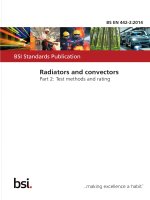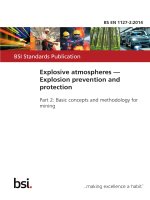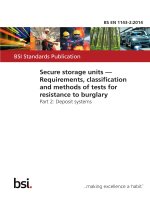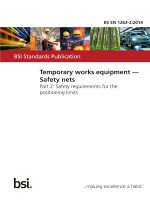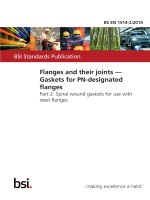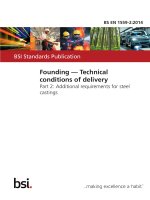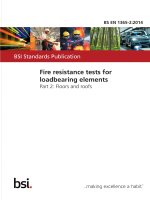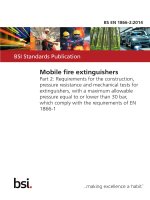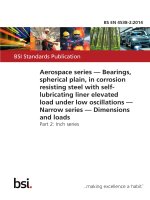Bsi bs en 61784 2 2014
Bạn đang xem bản rút gọn của tài liệu. Xem và tải ngay bản đầy đủ của tài liệu tại đây (3.76 MB, 294 trang )
BS EN 61784-2:2014
BSI Standards Publication
Industrial communication
networks — Profiles
Part 2: Additional fieldbus profiles
for real-time networks based on
ISO/IEC 8802-3
BS EN 61784-2:2014 BRITISH STANDARD
National foreword
This British Standard is the UK implementation of EN 61784-2:2014. It
is identical to IEC 61784-2:2014. It supersedes BS EN 61784-2:2010
which is withdrawn.
The UK participation in its preparation was entrusted to Technical
Committee AMT/7, Industrial communications: process measurement
and control, including fieldbus.
A list of organizations represented on this committee can be obtained on
request to its secretary.
This publication does not purport to include all the necessary provisions of
a contract. Users are responsible for its correct application.
© The British Standards Institution 2014.
Published by BSI Standards Limited 2014
ISBN 978 0 580 76950 4
ICS 35.100.20; 35.240.50
Compliance with a British Standard cannot confer immunity from
legal obligations.
This British Standard was published under the authority of the
Standards Policy and Strategy Committee on 31 October 2014.
Amendments/corrigenda issued since publication
Date Text affected
EUROPEAN STANDARD EN 61784-2
NORME EUROPÉENNE
EUROPÄISCHE NORM October 2014
ICS 35.100.20; 35.240.50 Supersedes EN 61784-2:2010
English Version
Industrial communication networks - Profiles - Part 2: Additional
fieldbus profiles for real-time networks based on ISO/IEC 8802-3
(IEC 61784-2:2014)
Réseaux de communication industriels - Profils - Partie 2: Industrielle Kommunikationsnetze - Profile - Teil 2:
Profils de bus de terrain supplémentaires pour les réseaux Zusätzliche Feldbusprofile für Echtzeitnetzwerke basierend
en temps réel basés sur l'ISO/CEI 8802-3 auf ISO/IEC 8802-3
(CEI 61784-2:2014) (IEC 61784-2:2014)
This European Standard was approved by CENELEC on 2014-08-21. CENELEC members are bound to comply with the CEN/CENELEC
Internal Regulations which stipulate the conditions for giving this European Standard the status of a national standard without any alteration.
Up-to-date lists and bibliographical references concerning such national standards may be obtained on application to the CEN-CENELEC
Management Centre or to any CENELEC member.
This European Standard exists in three official versions (English, French, German). A version in any other language made by translation
under the responsibility of a CENELEC member into its own language and notified to the CEN-CENELEC Management Centre has the
same status as the official versions.
CENELEC members are the national electrotechnical committees of Austria, Belgium, Bulgaria, Croatia, Cyprus, the Czech Republic,
Denmark, Estonia, Finland, Former Yugoslav Republic of Macedonia, France, Germany, Greece, Hungary, Iceland, Ireland, Italy, Latvia,
Lithuania, Luxembourg, Malta, the Netherlands, Norway, Poland, Portugal, Romania, Slovakia, Slovenia, Spain, Sweden, Switzerland,
Turkey and the United Kingdom.
European Committee for Electrotechnical Standardization
Comité Européen de Normalisation Electrotechnique
Europäisches Komitee für Elektrotechnische Normung
CEN-CENELEC Management Centre: Avenue Marnix 17, B-1000 Brussels
© 2014 CENELEC All rights of exploitation in any form and by any means reserved worldwide for CENELEC Members.
Ref. No. EN 61784-2:2014 E
BS EN 61784-2:2014
EN 61784-2:2014 - 2 -
Foreword
The text of document 65C/761/FDIS, future edition 3 of IEC 61784-2, prepared by SC 65C "Industrial
networks" of IEC/TC 65 "Industrial-process measurement, control and automation" was submitted to
the IEC-CENELEC parallel vote and approved by CENELEC as EN 61784-2:2014.
The following dates are fixed:
• latest date by which the document has to be implemented at (dop) 2015-05-21
national level by publication of an identical national
standard or by endorsement
• latest date by which the national standards conflicting with (dow) 2017-08-21
the document have to be withdrawn
This document supersedes EN 61784-2:2010.
Attention is drawn to the possibility that some of the elements of this document may be the subject of
patent rights. CENELEC [and/or CEN] shall not be held responsible for identifying any or all such
patent rights.
Endorsement notice
The text of the International Standard IEC 61784-2:2014 was approved by CENELEC as a European
Standard without any modification.
BS EN 61784-2:2014
- 3 - EN 61784-2:2014
Annex ZA
(normative)
Normative references to international publications
with their corresponding European publications
The following documents, in whole or in part, are normatively referenced in this document and are
indispensable for its application. For dated references, only the edition cited applies. For undated
references, the latest edition of the referenced document (including any amendments) applies.
NOTE 1 When an International Publication has been modified by common modifications, indicated by (mod),
the relevant EN/HD applies.
NOTE 2 Up-to-date information on the latest versions of the European Standards listed in this annex is
available here: www.cenelec.eu.
Publication Year Title EN/HD Year
IEC 61010 series EN 61010 series
IEC 61131-2 - Safety requirements for electrical EN 61131-2 -
IEC 61158 series equipment for measurement, control and EN 61158 series
IEC 61158-1 2014 laboratory use EN 61158-1 2014
IEC 61158-2 2014 Programmable controllers - EN 61158-2 2014
Part 2: Equipment requirements and
IEC 61158-3-2 2014 tests EN 61158-3-2 2014
IEC 61158-3-4 2014 Industrial communication networks - EN 61158-3-4 2014
Fieldbus specifications
IEC 61158-3-11 2007 EN 61158-3-11 2008
Industrial communication networks -
IEC 61158-3-12 2014 Fieldbus specifications - EN 61158-3-12 2014
Part 1: Overview and guidance for the
IEC 61158 and IEC 61784 series
Industrial communication networks -
Fieldbus specifications -
Part 2: Physical layer specification and
service definition
Industrial communication networks -
Fieldbus specifications -
Part 3-2: Data-link layer service
definition - Type 2 elements
Industrial communication networks -
Fieldbus specifications -
Part 3-4: Data-link layer service
definition - Type 4 elements
Industrial communication networks -
Fieldbus specifications -
Part 3-11: Data-link layer service
definition - Type 11 elements
Industrial communication networks -
Fieldbus specifications -
Part 3-12: Data-link layer service
definition - Type 12 elements
BS EN 61784-2:2014
EN 61784-2:2014 - 4 -
Publication Year Title EN/HD Year
IEC 61158-3-13 2014 EN 61158-3-13 2014
IEC 61158-3-14 2014 Industrial communication networks -
IEC 61158-3-17 2007 Fieldbus specifications - EN 61158-3-14 2014
IEC 61158-3-19 2014 Part 3-13: Data link layer service
IEC 61158-3-21 2010 definition - Type 13 elements EN 61158-3-17 2008
IEC 61158-3-22 2014
IEC 61158-4-2 2014 Industrial communication networks - EN 61158-3-19 2014
IEC 61158-4-4 2014 Fieldbus specifications -
IEC 61158-4-11 2014 Part 3-14: Data-link layer service EN 61158-3-21 2012
IEC 61158-4-12 2014 definition - Type 14 elements
IEC 61158-4-13 2014 EN 61158-3-22 2014
IEC 61158-4-14 2014 Industrial communication networks - EN 61158-4-2 1)
Fieldbus specifications - EN 61158-4-4 1)
Part 3-17: Data-link layer service EN 61158-4-11 1)
definition - Type 17 elements EN 61158-4-12 1)
EN 61158-4-13 1)
Industrial communication networks - EN 61158-4-14 1)
Fieldbus specifications -
Part 3-19: Data-link layer service
definition - Type 19 elements
Industrial communication networks -
Fieldbus specifications -
Part 3-21: Data-link layer service
definition - Type 21 elements
Industrial communication networks -
Fieldbus specifications -
Part 3-22: Data-link layer service
definition - Type 22 elements
Industrial communication networks -
Fieldbus specifications -
Part 4-2: Data-link layer protocol
specification - Type 2 elements
Industrial communication networks -
Fieldbus specifications -
Part 4-4: Data-link layer protocol
specification - Type 4 elements
Industrial communication networks -
Fieldbus specifications -
Part 4-11: Data-link layer protocol
specificationn - Type 11 elements
Industrial communication networks -
Fieldbus specifications -
Part 4-12: Data-link layer protocol
specification - Type 12 elements
Industrial communication networks -
Fieldbus specifications -
Part 4-13: Data-link layer protocol
specification - Type 13 elements
Industrial communication networks -
Fieldbus specifications -
Part 4-14: Data-link layer protocol
specification - Type 14 elements
1) To be published.
- 5 - BS EN 61784-2:2014
EN 61784-2:2014
Publication Year Title EN/HD Year
IEC 61158-4-17 2007 EN 61158-4-17 2008
IEC 61158-4-19 2014 Industrial communication networks -
IEC 61158-4-21 2010 Fieldbus specifications - EN 61158-4-19 1)
IEC 61158-4-22 2014 Part 4-17: Data-link layer protocol
IEC 61158-5-2 2014 specification - Type 17 elements EN 61158-4-21 2012
IEC 61158-5-4 2014 EN 61158-4-22 1)
IEC 61158-5-10 2014 Industrial communication networks -
IEC 61158-5-11 2007 Fieldbus specifications - EN 61158-5-2 2014
IEC 61158-5-12 2014 Part 4-19: Data-link layer protocol
IEC 61158-5-13 2014 specification - Type 19 elements EN 61158-5-4 2014
IEC 61158-5-14 2014
IEC 61158-5-15 2010 Industrial communication networks - EN 61158-5-10 2014
IEC 61158-5-17 2007 Fieldbus specifications -
Part 4-21: Data-link layer protocol EN 61158-5-11 2008
specification - Type 21 elements
EN 61158-5-12 2014
Industrial communication networks -
Fieldbus specifications - EN 61158-5-13 2014
Part 4-22: Data-link layer protocol
specification - Type 22 elements EN 61158-5-14 2014
Industrial communication networks - EN 61158-5-15 2012
Fieldbus specifications -
Part 5-2: Application layer service EN 61158-5-17 2008
definition - Type 2 elements
Industrial communication networks -
Fieldbus specifications -
Part 5-4: Application layer service
definition - Type 4 elements
Industrial communication networks -
Fieldbus specifications -
Part 5-10: Application layer service
definition - Type 10 elements
Industrial communication networks -
Fieldbus specifications -
Part 5-11: Application layer service
definition - Type 11 elements
Industrial communication networks -
Fieldbus specifications -
Part 5-12: Application layer service
definition - Type 12 elements
Industrial communication networks -
Fieldbus specifications -
Part 5-13: Application layer service
definition - Type 13 elements
Industrial communication networks -
Fieldbus specifications -
Part 5-14: Application layer service
definition - Type 14 elements
Industrial communication networks -
Fieldbus specifications -
Part 5-15: Application layer service
definition - Type 15 elements
Industrial communication networks -
Fieldbus specifications -
Part 5-17: Application layer service
definition - Type 17 elements
BS EN 61784-2:2014
EN 61784-2:2014 - 6 -
Publication Year Title EN/HD Year
IEC 61158-5-19 2014 EN 61158-5-19 2014
IEC 61158-5-21 2010 Industrial communication networks -
IEC 61158-5-22 2014 Fieldbus specifications - EN 61158-5-21 2012
IEC 61158-5-23 2014 Part 5-19: Application layer service
IEC 61158-6-2 2014 definition - Type 19 elements EN 61158-5-22 2014
IEC 61158-6-4 2014
IEC 61158-6-10 2014 Industrial communication networks - EN 61158-5-23 2014
IEC 61158-6-11 2007 Fieldbus specifications - EN 61158-6-2 1)
IEC 61158-6-12 2014 Part 5-21: Application layer service EN 61158-6-4 1)
IEC 61158-6-13 2014 definition - Type 21 elements EN 61158-6-10 1)
IEC 61158-6-14 2014
IEC 61158-6-15 2010 Industrial communication networks - EN 61158-6-11 2008
IEC 61158-6-17 2007 Fieldbus specifications - EN 61158-6-12 1)
Part 5-22: Application layer service EN 61158-6-13 1)
definition - Type 22 elements EN 61158-6-14 1)
Industrial communication networks - EN 61158-6-15 2012
Fieldbus specifications -
Part 5-23: Application layer service EN 61158-6-17 2008
definition - Type 23 elements
Industrial communication networks -
Fieldbus specifications -
Part 6-2: Application layer protocol
specification - Type 2 elements
Industrial communication networks -
Fieldbus specifications -
Part 6-4: Application layer protocol
specification - Type 4 elements
Industrial communication networks -
Fieldbus specifications -
Part 6-10: Application layer protocol
specification - Type 10 elements
Industrial communication networks -
Fieldbus specifications -
Part 6-11: Application layer protocol
specification - Type 11 elements
Industrial communication networks -
Fieldbus specifications -
Part 6-12: Application layer protocol
specification - Type 12 elements
Industrial communication networks -
Fieldbus specifications -
Part 6-13: Application layer protocol
specification - Type 13 elements
Industrial communication networks -
Fieldbus specifications -
Part 6-14: Application layer protocol
specification - Type 14 elements
Industrial communication networks -
Fieldbus specifications -
Part 6-15: Application layer protocol
specification - Type 15 elements
Industrial communication networks -
Fieldbus specifications -
Part 6-17: Application layer protocol
specification - Type 17 elements
BS EN 61784-2:2014
- 7 - EN 61784-2:2014
Publication Year Title EN/HD Year
IEC 61158-6-19 2014 EN 61158-6-19
Industrial communication networks - 1)
IEC 61158-6-21 2010 Fieldbus specifications - EN 61158-6-21
Part 6-19: Application layer protocol 2012
IEC 61158-6-22 2014 specification - Type 19 elements EN 61158-6-22
1)
IEC 61158-6-23 2014 Industrial communication networks - EN 61158-6-23
Fieldbus specifications - 1)
IEC 61588 2009 Part 6-21: Application layer protocol -
IEC 61784-1 2014 specification - Type 21 elements EN 61784-1 -
IEC 61784-5-2 2013 EN 61784-5-2
Industrial communication networks - 1)
IEC 61784-5-3 2013 Fieldbus specifications - EN 61784-5-3
Part 6-22: Application layer protocol 2013
IEC 61784-5-6 2013 specification - Type 22 elements EN 61784-5-6
2013
IEC 61784-5-8 2013 Industrial communication networks - EN 61784-5-8
Fieldbus specifications - 2013
IEC 61784-5-11 2013 Part 6-23: Application layer protocol EN 61784-5-11
specification - Type 23 elements 2013
IEC 61800 series EN 61800
IEC 61918 (mod) 2013 Precision clock synchronization protocol EN 61918 2013
- - for networked measurement and control + AC
ISO/IEC 2382-16 1996 systems - series
2013
Industrial communication networks - 2014
Profiles - -
Part 1: Fieldbus profiles
Industrial communication networks -
Profiles -
Part 5-2: Installation of fieldbuses -
Installation profiles for CPF 2
Industrial communication networks -
Profiles -
Part 5-3: Installation of fieldbuses -
Installation profiles for CPF 3
Industrial communication networks -
Profiles -
Part 5-6: Installation of fieldbuses -
Installation profiles for CPF 6
Industrial communication networks -
Profiles -
Part 5-8: Installation of fieldbuses -
Installation profiles for CPF 8
Industrial communication networks -
Profiles -
Part 5-11: Installation of fieldbuses -
Installation profiles for CPF 11
Adjustable speed electrical power drive
systems
Industrial communication networks -
Installation of communication networks
in industrial premises
Information technology - Vocabulary -
Part 16: Information theory
BS EN 61784-2:2014
EN 61784-2:2014 - 8 -
Publication Year Title EN/HD Year
ISO/IEC 7498-1 - - -
Information technology - Open Systems - -
ISO/IEC 8802-2 - Interconnection - Basic Reference
Model: The Basic Model - -
ISO/IEC 8802-3 2000
Information technology - - -
ISO/IEC/IEEE 8802-11 - Telecommunications and information
exchange between systems - Local and - -
ISO/IEC 11801 2002 metropolitan area networks - Specific - -
+ A1 2008 requirements - - -
+ A2 2010 Part 2: Logical link control -
Information technology - -
Telecommunications and information -
exchange between systems - Local and -
metropolitan area networks - Specific -
requirements - -
Part 3: Carrier sense multiple access
with collision detection (CSMA/CD)
access method and physical layer
specifications
Information technology -
Telecommunications and information
exchange between systems - Local and
metropolitan area networks - Specific
requirements -
Part 11: Wireless LAN medium access
control (MAC) and physical layer (PHY)
specifications
Information technology - Generic cabling
for customer premises
ISO 15745-3 - Industrial automation systems and -
ISO 15745-4 integration - Open systems application
+ A1
IEEE Std 802 integration framework -
IEEE 802.1AB
IEEE 802.1AS Part 3: Reference description for
IEC 61158 based control systems
2003 Industrial automation systems and -
2006 integration - Open systems application -
integration framework -
Part 4: Reference description for
Ethernet-based control systems
2001 IEEE Standard for Local and -
Metropolitan Area Networks: Overview
and Architecture
- IEEE Standard for Local and -
Metropolitan Area Networks - Station
and Media Access Control Connectivity
Discovery
2011 IEEE Standard for Local and -
Metropolitan Area Networks - Timing
and Synchronization for Time-Sensitive
Applications in Bridged Local Area
Networks
BS EN 61784-2:2014
- 9 - EN 61784-2:2014
Publication Year Title EN/HD Year
IEEE 802.1D 2004 - -
IEEE 802.1Q 2011 IEEE Standard for Local and - -
Metropolitan Area Networks - Media
IEEE 802.3 2008 Access Control (MAC) Bridges - -
IEEE 802.11 2007 IEEE Standard for Local and - -
metropolitan area networks - Media
IEEE Std 802.15.1 - Access Control (MAC) Bridges and - -
Virtual Bridged Local Area Networks
IETF RFC 768 - - -
IETF RFC 791 - IEEE Standard for Information - -
IETF RFC 792 - technology - Telecommunications and - -
IETF RFC 793 - information exchange between - -
IETF RFC 826 - systems - Local and metropolitan area - -
networks - Specific requirements -
IETF RFC 894 - Part 3: Carrier Sense Multiple Access - -
IETF RFC 1034 - with Collision Detection (CSMA/CD) - -
IETF RFC 1112 - Access Method and Physical Layer - -
IETF RFC 1122 - Specifications - -
IETF RFC 1123 - - -
IETF RFC 1127 - IEEE Standard for Information - -
Technology - Telecommunications and
Information Exchange Between
Systems - Local and Metropolitan Area
Networks - Specific Requirements -
Part 11: Wireless LAN Medium Access
Control (MAC) and Physical Layer (PHY)
Specifications
IEEE Standard for Information
technology - Telecommunications and
information exchange between
systems - Local and metropolitan area
networks - Specific requirements. -
Part 15.1: Wireless medium access
control (MAC) and physical layer (PHY)
specifications for wireless personal area
networks (WPANs)
User Datagram Protocol
Internet Protocol
Internet Control Message Protocol
Transmission Control Protocol
Ethernet Address Resolution Protocol -
or - Converting Network Protocol
Addresses to 48.bit Ethernet Address for
Transmission on Ethernet Hardware
A Standard for the Transmission of IP
Datagrams over Ethernet Networks
Domain names - concepts and facilities
Host Extensions for IP Multicasting
Requirements for Internet Hosts -
Communication Layers
Requirements for Internet Hosts -
Application and Support
Perspective on the Host Requirements
RFCs
BS EN 61784-2:2014 - 10 -
EN 61784-2:2014
Publication Year Title EN/HD Year
IETF RFC 1157 - - -
IETF RFC 1213 - Simple Network Management Protocol - -
(SNMP)
IETF RFC 1305 - - -
Management Information Base for
IETF RFC 2131 - Network Management of TCP/IP-based - -
IETF RFC 2236 - Internets: MIB-II - -
IETF RFC 2544 - - -
IETF RFC 2988 - Network Time Protocol (Version 3) - -
IETF RFC 4836 - Specification, Implementation and - -
Analysis
OSF CAE - - -
Specification C706 Dynamic Host Configuration Protocol
Internet Group Management Protocol,
Version 2
Benchmarking Methodology for Network
Interconnect Devices
Computing TCP's Retransmission Timer
Definitions of Managed Objects for
IEEE 802.3 Medium Attachment Units
(MAUs)
Technical Standard DCE1.1: Remote
Procedure Call
– 2 – BS EN 61784-2:2014
IEC 61784-2:2014 © IEC 2014
CONTENTS
INTRODUCTION................................................................................................................... 17
1 Scope ............................................................................................................................ 18
2 Normative references .................................................................................................... 18
3 Terms, definitions, abbreviated terms, acronyms, and conventions ................................ 23
3.1 Terms and definitions....................................................................................... 23
3.2 Abbreviated terms and acronyms ..................................................................... 27
3.3 Symbols ........................................................................................................... 29
3.3.1 CPF 2 symbols ............................................................................... 29
3.3.2 CPF 3 symbols ............................................................................... 30
3.3.3 CPF 4 symbols ............................................................................... 31
3.3.4 CPF 6 symbols ............................................................................... 31
3.3.5 CPF 10 symbols ............................................................................. 32
3.3.6 CPF 11 symbols ............................................................................. 32
3.3.7 CPF 12 symbols ............................................................................. 33
3.3.8 CPF 13 symbols ............................................................................. 33
3.3.9 CPF 14 symbols ............................................................................. 34
3.3.10 CPF 15 symbols ............................................................................. 34
3.3.11 CPF 16 symbols ............................................................................. 35
3.3.12 CPF 17 symbols ............................................................................. 35
3.3.13 CPF 18 symbols ............................................................................. 36
3.4 Conventions..................................................................................................... 37
3.4.1 Conventions common to all layers .................................................. 37
3.4.2 Physical layer ................................................................................. 38
3.4.3 Data-link layer ................................................................................ 38
3.4.4 Application layer ............................................................................. 39
4 Conformance to communication profiles ........................................................................ 39
5 RTE performance indicators .......................................................................................... 40
5.1 Basic principles of performance indicators ....................................................... 40
5.2 Application requirements.................................................................................. 41
5.3 Performance indicators .................................................................................... 41
5.3.1 Delivery time .................................................................................. 41
5.3.2 Number of RTE end-stations...........................................................42
5.3.3 Basic network topology ................................................................... 42
5.3.4 Number of switches between RTE end-stations ..............................42
5.3.5 Throughput RTE ............................................................................. 42
5.3.6 Non-RTE bandwidth........................................................................ 42
5.3.7 Time synchronization accuracy ....................................................... 43
5.3.8 Non-time-based synchronization accuracy ...................................... 43
5.3.9 Redundancy recovery time ............................................................. 43
6 Conformance tests ........................................................................................................ 43
6.1 Concept ........................................................................................................... 43
6.2 Methodology .................................................................................................... 44
6.3 Test conditions and test cases ......................................................................... 44
6.4 Test procedure and measuring......................................................................... 44
6.5 Test report ....................................................................................................... 45
BS EN 61784-2:2014 – 3 –
IEC 61784-2:2014 © IEC 2014
7 Communication Profile Family 2 (CIP™) – RTE communication profiles.........................45
7.1 General overview ............................................................................................. 45
7.2 Profile 2/2 ........................................................................................................ 46
7.2.1 Physical layer ................................................................................. 46
7.2.2 Data-link layer ................................................................................ 46
7.2.3 Application layer ............................................................................. 46
7.2.4 Performance indicator selection ...................................................... 46
7.3 Profile 2/2.1 ..................................................................................................... 50
7.3.1 Physical layer ................................................................................. 50
7.3.2 Data-link layer ................................................................................ 50
7.3.3 Application layer ............................................................................. 52
7.3.4 Performance indicator selection ...................................................... 54
8 Communication Profile Family 3 (PROFIBUS & PROFINET) – RTE communication
profiles .......................................................................................................................... 55
8.1 General overview ............................................................................................. 55
8.1.1 CPF 3 overview .............................................................................. 55
8.1.2 Administrative numbers .................................................................. 55
8.1.3 Node Classes ................................................................................. 56
8.1.4 Timing parameters .......................................................................... 57
8.1.5 Communication classes .................................................................. 60
8.1.6 Media redundancy classes.............................................................. 63
8.1.7 Media classes................................................................................. 63
8.1.8 Application classes ......................................................................... 64
8.1.9 Records .......................................................................................... 67
8.1.10 Communication feature list ............................................................. 73
8.1.11 Conformance class behaviors ......................................................... 74
8.2 Profile 3/4 ........................................................................................................ 78
8.2.1 Physical layer ................................................................................. 78
8.2.2 Data link layer ................................................................................ 78
8.2.3 Application layer ............................................................................. 79
8.2.4 Performance indicator selection ...................................................... 86
8.3 Profile 3/5 ........................................................................................................ 93
8.3.1 Physical layer ................................................................................. 93
8.3.2 Data link layer ................................................................................ 93
8.3.3 Application layer ............................................................................. 93
8.3.4 Performance indicator selection .................................................... 100
8.4 Profile 3/6 ...................................................................................................... 102
8.4.1 Physical layer ............................................................................... 102
8.4.2 Data link layer .............................................................................. 102
8.4.3 Application layer ........................................................................... 102
8.4.4 Performance indicator selection .................................................... 109
9 Communication Profile Family 4 (P-NET) – RTE communication profiles ..................... 114
9.1 General overview ........................................................................................... 114
9.2 Profile 4/3, P-NET on IP................................................................................. 115
9.2.1 Physical layer ............................................................................... 115
9.2.2 Data-link layer .............................................................................. 115
9.2.3 Application layer ........................................................................... 116
9.2.4 Performance indicator selection .................................................... 117
10 Communication Profile Family 6 (INTERBUS®) – RTE communication profiles ............ 120
– 4 – BS EN 61784-2:2014
IEC 61784-2:2014 © IEC 2014
10.1 General overview ........................................................................................... 120
10.2 Profile 6/4 ...................................................................................................... 122
10.2.1 Mapping ....................................................................................... 122
10.2.2 Type 10 service and protocol selection ......................................... 123
10.2.3 Type 8 service and protocol selection ........................................... 123
10.2.4 Performance indicator selection .................................................... 124
10.3 Profile 6/5 ...................................................................................................... 125
10.3.1 Mapping ....................................................................................... 125
10.3.2 Type 10 service and protocol selection ......................................... 125
10.3.3 Type 8 service and protocol selection ........................................... 125
10.3.4 Performance indicator selection .................................................... 125
10.4 Profile 6/6 ...................................................................................................... 126
10.4.1 Mapping ....................................................................................... 126
10.4.2 Type 10 service and protocol selection ......................................... 126
10.4.3 Type 8 service and protocol selection ........................................... 126
10.4.4 Performance indicator selection .................................................... 126
11 Communication Profile Family 10 (Vnet/IP) – RTE communication profiles .................. 127
11.1 General overview ........................................................................................... 127
11.2 Profile 10/1 .................................................................................................... 128
11.2.1 Physical layer ............................................................................... 128
11.2.2 Data link layer .............................................................................. 128
11.2.3 Application layer ........................................................................... 130
11.2.4 Performance indicator selection .................................................... 131
12 Communication Profile Family 11 (TCnet) – RTE communication profiles .................... 136
12.1 General overview ........................................................................................... 136
12.2 Profile 11/1 .................................................................................................... 137
12.2.1 Physical layer ............................................................................... 137
12.2.2 Data-link layer .............................................................................. 137
12.2.3 Application layer ........................................................................... 141
12.2.4 Performance indicator selection .................................................... 141
12.3 Profile 11/2 .................................................................................................... 147
12.3.1 Physical layer ............................................................................... 147
12.3.2 Data-link layer .............................................................................. 147
12.3.3 Application layer ........................................................................... 151
12.3.4 Performance indicator selection .................................................... 151
12.4 Profile 11/3 .................................................................................................... 156
12.4.1 Physical layer ............................................................................... 156
12.4.2 Data-link layer .............................................................................. 156
12.4.3 Application layer ........................................................................... 159
12.4.4 Performance indicator selection .................................................... 160
13 Communication Profile Family 12 (EtherCAT®) – RTE communication profiles ............. 166
13.1 General overview ........................................................................................... 166
13.2 Profile CP 12/1 .............................................................................................. 166
13.2.1 Physical layer ............................................................................... 166
13.3 13.2.2 Data-link layer .............................................................................. 167
13.2.3 Application layer ........................................................................... 171
13.2.4 Performance indicator selection .................................................... 173
Profile CP 12/2 .............................................................................................. 176
13.3.1 Physical layer ............................................................................... 176
BS EN 61784-2:2014 – 5 –
IEC 61784-2:2014 © IEC 2014
13.3.2 Data-link layer .............................................................................. 176
13.3.3 Application layer ........................................................................... 179
13.3.4 Performance indicator selection .................................................... 181
14 Communication Profile Family 13 (Ethernet POWERLINK) – RTE communication
profiles ........................................................................................................................ 183
14.1 General overview ........................................................................................... 183
14.2 Profile 13/1 .................................................................................................... 183
14.2.1 Physical layer ............................................................................... 183
14.2.2 Data-link layer .............................................................................. 184
14.2.3 Application layer ........................................................................... 184
14.2.4 Performance indicator selection .................................................... 184
15 Communication Profile Family 14 (EPA)- RTE communication profiles......................... 189
15.1 General overview ........................................................................................... 189
15.2 CPF 14 (EPA) communication concept........................................................... 190
15.2.1 General ........................................................................................ 190
15.2.2 Network Topology......................................................................... 190
15.2.3 EPA devices ................................................................................. 191
15.3 Profile 14/1 .................................................................................................... 192
15.3.1 Physical layer ............................................................................... 192
15.3.2 Data-link layer .............................................................................. 192
15.3.3 Network Layer .............................................................................. 192
15.3.4 Transport Layer ............................................................................ 192
15.3.5 Application layer ........................................................................... 192
15.3.6 Performance indicator selection .................................................... 193
15.4 Profile 14/2 .................................................................................................... 196
15.4.1 Physical layer ............................................................................... 196
15.4.2 Data-link layer .............................................................................. 196
15.4.3 Network Layer .............................................................................. 197
15.4.4 Transport Layer ............................................................................ 197
15.4.5 Application layer ........................................................................... 197
15.4.6 Performance indicator selection .................................................... 198
15.5 Profile 14/3 .................................................................................................... 201
15.5.1 Physical layer ............................................................................... 201
15.5.2 Data-link layer .............................................................................. 201
15.5.3 Network Layer .............................................................................. 202
15.5.4 Transport Layer ............................................................................ 202
15.5.5 Application layer ........................................................................... 202
15.5.6 Performance indicator selection .................................................... 203
15.6 Profile 14/4 .................................................................................................... 206
15.6.1 Physical layer ............................................................................... 206
15.6.2 Data-link layer .............................................................................. 206
15.6.3 Network layer ............................................................................... 207
15.6.4 Transport layer ............................................................................. 208
15.6.5 Application layer ........................................................................... 208
15.6.6 Performance indicatior selection ................................................... 209
16 Communication Profile Family 15 (MODBUS-RTPS) – RTE communication profiles..... 211
16.1 General overview ........................................................................................... 211
16.2 Profile 15/1 .................................................................................................... 212
16.2.1 Physical layer ............................................................................... 212
– 6 – BS EN 61784-2:2014
IEC 61784-2:2014 © IEC 2014
16.2.2 Data-link layer .............................................................................. 212
16.2.3 Application layer ........................................................................... 212
16.2.4 Performance indicator selection .................................................... 212
16.3 Profile 15/2 .................................................................................................... 217
16.3.1 Physical layer ............................................................................... 217
16.3.2 Data-link layer .............................................................................. 217
16.3.3 Application layer ........................................................................... 217
16.3.4 Performance indicator selection .................................................... 218
17 Communication Profile Family 16 (SERCOS)- RTE communication profiles ................. 222
17.1 General overview ........................................................................................... 222
17.2 Profile 16/3 (SERCOS III) .............................................................................. 222
17.2.1 Physical layer ............................................................................... 222
17.2.2 Data-link layer .............................................................................. 223
17.2.3 Application layer ........................................................................... 223
17.2.4 Performance indicator selection .................................................... 224
18 Communication Profile Family 17(RAPIEnet) – RTE communication profiles................ 230
18.1 General overview ........................................................................................... 230
18.2 Profile 17/1 .................................................................................................... 230
18.2.1 Physical layer ............................................................................... 230
18.2.2 Datalink layer ............................................................................... 230
18.2.3 Application layer ........................................................................... 231
18.2.4 Performance indicator selection .................................................... 232
19 Communication Profile Family 18 (SafetyNET p) – RTE communication profiles .......... 236
19.1 General overview ........................................................................................... 236
19.2 Profile 18/1 .................................................................................................... 236
19.2.1 Physical layer ............................................................................... 236
19.2.2 Data link layer .............................................................................. 236
19.2.3 Application layer ........................................................................... 239
19.2.4 Performance indicator selection .................................................... 240
19.3 Profile 18/2 .................................................................................................... 243
19.3.1 Physical layer ............................................................................... 243
19.3.2 Data link layer .............................................................................. 243
19.3.3 Application layer ........................................................................... 245
19.3.4 Performance indicator selection .................................................... 247
20 Communication Profile Family 8 (CC-Link) – RTE communication profiles ................... 249
20.1 General overview ........................................................................................... 249
20.2 Profile 8/4 ...................................................................................................... 249
20.2.1 Physical layer ............................................................................... 249
20.2.2 Data link layer .............................................................................. 249
20.2.3 Application layer ........................................................................... 250
20.2.4 Performance indicator selection .................................................... 251
20.3 Profile 8/5 ...................................................................................................... 256
20.3.1 Physical layer ............................................................................... 256
20.3.2 Data link layer .............................................................................. 256
20.3.3 Application layer ........................................................................... 256
20.3.4 Performance indicator selection .................................................... 257
Annex A (informative) Performance Indicator calculation ................................................... 263
Bibliography........................................................................................................................ 283
BS EN 61784-2:2014 – 7 –
IEC 61784-2:2014 © IEC 2014
Figure 1 – Example of graphical representation of consistent indicators................................41
Figure 2 – Conformance test overview .................................................................................. 43
Figure 3 – Example of network topology using CP 3/4, CP 3/5, and CP 3/6 components .......78
Figure 4 – Example of network topology with wireless segment ............................................ 81
Figure 5 – Calculation basis for delivery time and throughput RTE........................................89
Figure 6 – Linking-device communication profiles RTE-network context .............................. 121
Figure 7 – Linking-device mapping principle ....................................................................... 122
Figure 8 – Data Mapping..................................................................................................... 122
Figure 9 – CP 11/1: Throughput RTE and non-RTE bandwidth ............................................ 144
Figure 10 – CP 11/2: Throughput RTE and non-RTE bandwidth .......................................... 154
Figure 11 – CP 11/3: Throughput RTE and non-RTE bandwidth .......................................... 163
Figure 12 – EPA system network topology example ............................................................ 191
Figure A.1 – CP 3/4: Example of line structure.................................................................... 265
Figure A.2 – CP 3/4: Example of ring structure ................................................................... 266
Figure A.3 – CP 3/4: Example of a wireless segment .......................................................... 266
Figure A.4 – CP 3/4: Example of an integrated wireless client............................................. 267
Figure A.5 – CP 3/5: Example of line structure.................................................................... 267
Figure A.6 – CP 3/5: Example of ring structure ................................................................... 268
Figure A.7 – CP 3/6: Example of line structure.................................................................... 269
Figure A.8 – CP 3/6: Example of line structure.................................................................... 270
Figure A.9 – CP 3/6: Example of ring structure ................................................................... 271
Figure A.10 – CP 3/6: Example of tree structure ................................................................. 272
Figure A.11 – CP 3/6: Example of comb structure ............................................................... 273
Figure A.12 – CP 3/6: Example of comb structure (optional) ............................................... 274
Figure A.13 – Definition of bridge delay .............................................................................. 275
Figure A.14 – Example of a switch structure ....................................................................... 276
Figure A.15 – Application configuration............................................................................... 277
Figure A.16 – Non-RTE throughput calculation ................................................................... 279
Figure A.17 – Non time-base synchronization accuracy ...................................................... 279
Table 1 – Layout of profile (sub)clause selection tables ........................................................ 37
Table 2 – Contents of (sub)clause selection tables ............................................................... 37
Table 3 – Layout of service selection tables.......................................................................... 37
Table 4 – Contents of service selection tables ...................................................................... 38
Table 5 – Layout of parameter selection tables ..................................................................... 38
Table 6 – Contents of parameter selection tables ................................................................. 38
Table 7 – Layout of class attribute selection tables ............................................................... 39
Table 8 – Contents of class attribute selection tables............................................................ 39
Table 9 – Basic network topology types ................................................................................ 42
Table 10 – CP 2/2: PI overview ............................................................................................. 46
Table 11 – CP 2/2: PI dependency matrix ............................................................................. 47
Table 12 – CP 2/2: Consistent set of PIs for factory automation ............................................ 50
– 8 – BS EN 61784-2:2014
IEC 61784-2:2014 © IEC 2014
Table 13 – CP 2/2.1: DLL protocol selection ......................................................................... 51
Table 14 – CP 2/2.1: DLL protocol selection of management objects ....................................51
Table 15 – CP 2/2.1: AL service selection............................................................................. 52
Table 16 – CP 2/2.1: AL protocol selection ........................................................................... 53
Table 17 – CP 2/2.1: PI overview .......................................................................................... 54
Table 18 – CP 2/2.1: PI dependency matrix .......................................................................... 54
Table 19 – CP 2/2.1: Consistent set of PIs for motion control................................................55
Table 20 – Administrative numbers assignment .................................................................... 56
Table 21 – IP layer parameters for IO controller.................................................................... 57
Table 22 – IP layer parameters for IO device ........................................................................ 57
Table 23 – Timeout values for name resolution ..................................................................... 58
Table 24 – Reaction time for an IO device ............................................................................ 58
Table 25 – Maximum time values for MRP ............................................................................ 59
Table 26 – Maximum time values for PTCP........................................................................... 59
Table 27 – Maximum time values for LLDP ........................................................................... 60
Table 28 – Communication classes applicable in conformance classes.................................60
Table 29 – Communication performance parameters ............................................................ 61
Table 30 – Parameters for RT_CLASS_3 bridges.................................................................. 61
Table 31 – FrameSendOffset deviation ................................................................................. 61
Table 32 – FrameSendOffset deviation for RT_CLASS_1 / RT_CLASS_UDP ........................62
Table 33 – Minimum FrameSendOffset ................................................................................. 62
Table 34 – PTCP control loop ............................................................................................... 62
Table 35 – Maximum frame size ........................................................................................... 63
Table 36 – Media redundancy class applicable in conformance classes ................................63
Table 37 – Application classes applicable in conformance classes for IO device and
IO controller.......................................................................................................................... 64
Table 38 – Application classes applicable in conformance classes for network
components .......................................................................................................................... 64
Table 39 – Application class “isochronous application” AL service selection ......................... 65
Table 40 – Application class “isochronous application” AL protocol selection
component ............................................................................................................................ 65
Table 41 – Application class “process automation” AL service selection................................65
Table 42 – Application class “process automation” AL protocol selection component ............65
Table 43 – Application class “High performance” features supported ....................................66
Table 44 – Application class “High performance” parameter values.......................................66
Table 45 – Application class “Controller to controller” features supported .............................66
Table 46 – Index (user specific) ............................................................................................ 67
Table 47 – Index (subslot specific)........................................................................................ 67
Table 48 – Index (slot specific) ............................................................................................. 69
Table 49 – Index (AR specific) .............................................................................................. 69
Table 50 – Index (API specific) ............................................................................................. 71
Table 51 – Index (device specific)......................................................................................... 72
Table 52 – PDPortDataAdjust (sub blocks) ........................................................................... 73
Table 53 – PDPortDataCheck (sub blocks) ........................................................................... 73
BS EN 61784-2:2014 – 9 –
IEC 61784-2:2014 © IEC 2014
Table 54 – Communication feature list .................................................................................. 74
Table 55 – Conformance class behaviors.............................................................................. 74
Table 56 – MIB-II objects ...................................................................................................... 76
Table 57 – Conformance class behaviors for network components........................................77
Table 58 – CP 3/4: AL service selection for an IO device ...................................................... 79
Table 59 – CP 3/4: AL protocol selection for an IO device and Network component ..............82
Table 60 – CP 3/4: AL protocol selection for an IO controller ................................................ 84
Table 61 – CP 3/4, CP 3/5 and CP 3/6: Performance indicator overview ...............................87
Table 62 – CP 3/4, CP 3/5 and CP 3/6: PI dependency matrix ..............................................87
Table 63 – Manager parameters ........................................................................................... 90
Table 64 – Client parameters ................................................................................................ 91
Table 65 – CP 3/4: Consistent set of PIs for MinDeviceInterval=128 ms................................92
Table 66 – CP 3/4: Assumed values for consistent set of PI calculation ................................92
Table 67 – CP 3/5: AL service selection for an IO device ...................................................... 94
Table 68 – CP 3/5: AL protocol selection for an IO device and Network component ..............96
Table 69 – Buffering capacity for less than eight ports .......................................................... 98
Table 70 – Buffering capacity for eight and more ports ......................................................... 98
Table 71 – CP 3/5: AL protocol selection for an IO controller ................................................ 98
Table 72 – CP 3/5: Consistent set of PIs for MinDeviceInterval=128 ms.............................. 101
Table 73 – CP 3/5: Assumed values for consistent set of PI calculation .............................. 101
Table 74 – CP 3/6: AL service selection for an IO device .................................................... 103
Table 75 – Buffering capacity.............................................................................................. 105
Table 76 – CP 3/6: AL protocol selection for an IO device and network component............. 105
Table 77 – CP 3/6: AL protocol selection for an IO controller .............................................. 107
Table 78 – CP 3/6: Consistent set of PIs for MinDeviceInterval=1 ms and
NumberOfSwitches=20 ....................................................................................................... 110
Table 79 – CP 3/6: Consistent set of PI for MinDeviceInterval=1 ms and
NumberOfSwitches=63 ....................................................................................................... 111
Table 80 – CP 3/6: Assumed values for consistent set of PI calculation .............................. 112
Table 81 – CP 3/6: Consistent set of PIs for MinDeviceInterval=31,25 µs and
NumberOfSwitches=10 ....................................................................................................... 113
Table 82 – CP 3/6: Assumed values for consistent set of PI calculation .............................. 114
Table 83 – CP 4/3: DLL service selection............................................................................ 115
Table 84 – CP 4/3: DLL protocol selection .......................................................................... 116
Table 85 – CP 4/3: AL service selection.............................................................................. 116
Table 86 – CP 4/3: AL protocol selection ............................................................................ 116
Table 87 – CP 4/3: PI overview ........................................................................................... 117
Table 88 – CP 4/3: PI dependency matrix ........................................................................... 117
Table 89 – CP 4/3: Consistent set of PIs............................................................................. 120
Table 90 – Parameters for calculation of consistent set of PIs ............................................ 120
Table 91 – CPF 6: device CP identifier assignment............................................................. 121
Table 92 – Linking-device Type 10 network PI overview ..................................................... 124
Table 93 – OSI layers and CPF 10 layers ........................................................................... 127
Table 94 – Overview of CPF 10 profile................................................................................ 127

